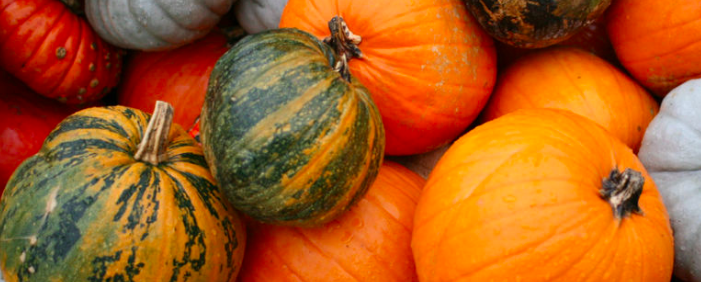
Since the 90s, in France we associate the period of All Saints to Halloween, a party from across the Atlantic. On the evening of October 31, everything is good to be scared: skeletons, ghosts, witches, zombies … and grinning pumpkins! Squash and pumpkins are indeed kings in this season: their colors brighten market stalls, and pumpkin dug and illuminated with a candle has become the symbol of Halloween (thus reliving the Irish legend of Jack O’Lantern). But by the way, is it a pumpkin, a squash or a pumpkin? Rediscover Cucurbitaceae, from the most known to the most unexpected …
Cucurbitaceae, a very varied family
Cucurbitaceae form a vast botanical family. With 130 genera, 800 species and some 10,000 varieties , it offers an impressive diversity of fruits: squash, zucchini, pumpkins, pumpkins, pumpkins, pastries, colocynth, calabashes, cucumbers, melons and watermelons … Not easy to see clearly … How to classify all this little world?
Only 6 of 130 genera are widely grown in the world. The best known is the genus Cucurbita , which is also the most diversified in terms of edible fruit varieties: there are all shapes, sizes, colors, and for all tastes! It comes in 5 species, including:
- Cucurbita pepo : zucchini, squash (Vegetable Spaghetti, Jasmine of Vendée …), pumpkins (Pumpkin of Touraine), pastries, colocynth, pomarines.
- Cucurbita moschata : butternut squash and all the varieties that come from it, whose flesh is sweet (Doubeurre, Butternut, Sucrine of Berry, Nice long …).
- Cucurbita maxima : pumpkins (Atlantic Giant which holds the size record, Bright Red of Etampes, Hungarian Blue, Galeuse of Eysines …), pumpkins and giraumons.
- Cucurbita ficifolia : mention the squash of Siam, with black seeds.
- Cucurbita argyrosperma : the squash of Mexico, little known in Europe.
The other 5 genres are less diversified. The genus Citrullus includes watermelons ( Citrullus lanatus ), the genus Cucumis gathers cucumbers ( Cucumis sativus ) and melons ( Cucumis melo ). As for the genus Sechium , it is that of chayotes ( Sechium edule ).
Decorative or utilitarian cucurbits
Some Cucurbitaceae have been cultivated for millennia to serve as containers: they are the famous gourds ( genus Lagenaria ), or calabashes. When drying, their skin becomes very hard: depending on the size and shape of the fruit, they can serve as a spoon, a cup, a bottle, a vase, a float, a musical instrument …
Another curiosity is the genus Luffa , in which the pulp of the fruit becomes dry and fibrous at maturity: the bark is removed to obtain a vegetable sponge (traditionally used for household chores … but also for skin care).
Other Cucurbitaceae are cultivated for their ornamental qualities: unusual shapes, bright and contrasting colors, and excellent preservation! There are dozens of varieties, different types of apartment: decorative calabashes (Squash Club Hercules, Caveman’s Club, Dipper, Cobra …), colocynth (Claws of the Devil, Bottle Squash …), or Cucumis with spiky fruits. thorns ( C. carolinus, C. longipes …).
Ancient and modern varieties
With squash and pumpkins, lovers of old varieties have something to celebrate! The seeds catalogs of course offer modern varieties, including F1 hybrids , but also a good range of old varieties. It must be said that the old varieties are numerous in squash and pumpkins, with nearly 60 “old varieties for amateur” listed on the French Official Catalog (it is less than for tomatoes, which holds the record in the material, but it is significantly more than for other plants in the garden).
Some culture tips
The cultivation of squash in the kitchen garden is easy! The only real constraint: to have room, especially for the “runner” varieties .
Sow them in 3-seeded pans, either in pots around mid-April (to be transplanted in May), or directly in place and in warm ground in mid-May, spacing them from 1 to 2 meters depending on the variety. Fill the planting holes with compost or well decomposed manure (squash and pumpkins are very greedy in manure!). Native to South and Central America, they are also chilly: book them a sunny and hot location. Water the seedlings regularly and watch for slugs.
During the summer, water in dry weather, without wetting the foliage (risk of powdery mildew), and straw the soil. In September, when fruits are approaching ripeness, isolate them from soil moisture by placing them on a tile or flat stone. Harvest them before the frosts and keep them in a cool (10 ° C) and dry place.
Note that Cucurbitaceae belonging to the same species hybridize very easily between them. If you intend to recover the seeds to sow the following year, beware of hybridizations! Do not grow different varieties of the same species.